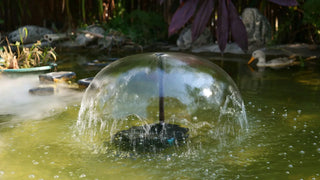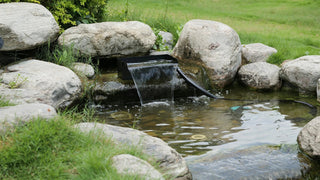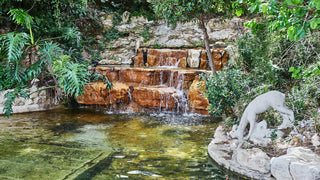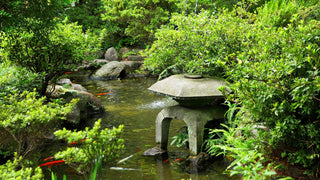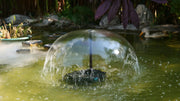
You can build the prettiest pond in the neighborhood and still find yourself staring at green water by July. Clarity is not an accident—filtration successfully achieved. The good news: you don't have to guess. With a few simple guidelines, as well as eco-friendly equipment from the Poposoap product line (filters, solar pumps, and accessories focused on minimal-maintenance ecology in the Poposoap Product Manual and company history), you can match a filter to your pond and keep it crystal clear seasonally.
Significance of Filtration
Filtration is the center of garden pond filtration. It does two things:
- Mechanical: physically restrains leaves, fish waste, leftover food, and silt so they don't recirculate to the water column.
- Biological: provides surface area for beneficial bacteria that metabolize toxic ammonia → nitrite → much less toxic nitrate.
Balance this, and you inhibit algae, provide pH stability, and minimize fish stress. Be economical, and you will battle cloudy water, string algae, and odor. Poposoap's design philosophy gambles everything on ecosystem thinking—steady flow, ample media volume, and simple accessibility for maintenance—so the equipment works in conjunction with, not in opposition to, pond biology.
Types of Filters
There are lots of different types of pond filters, but most fit into some reasonable categories. Knowing what they are helps you to compare mechanical vs. biological filters and select an arrangement that is suitable for your space and goals.
Filter boxes / canisters (mechanical + biological)

The small box with recyclable pads and porous media (e.g., ceramic rings, bio-balls). Water in, trash gets filtered first; bacteria colonize the media in back. Poposoap filter boxes remain with this multi-stage design, simple to clean and tolerant for newbies.
Waterfall filters (mechanical + biological + display)

Media stays in a spillway on top of a stream or cascade. You have filtration and a scenic drop that adds oxygen. Nice if you only want an active feature without extra equipment.
Pressurized canisters (mechanical + biological, addl. UV)

Closed units you can hide behind bushes. These have some head pressure to supply top waterfalls. Some have UV clarifiers to keep free-floating "green water" algae in check. (UV smooths water but is not a replacement for biofiltration.)
Skimmers (mechanical)

A surface box that suctions in floating trash before it reaches the bottom. Best used with a biofilter downstream.
Most productive ponds employ a combination of types: for example, a skimmer (detritus) and a bio-intensive filter box or waterfall (biology). Poposoap's guide recommends modularity—start with a filter box and add a skimmer or spillway later as the pond or fish load grows.
Sizing Based on Pond Volume
Undersizing is the number-one mistake. If unsure, oversize the filter—especially if you have goldfish or koi.
1. Calculate volume
Use feet for quick math: Length × Width × Average Depth × 7.48 = gallons.
Example: an 8 × 6 × 2 ft pond → 8×6=48; 48×2=96; 96×7.48 ≈ 718 gallons.
2. Size the filter, not just the pump
Filter manufacturers are rated to a maximum pond size. Think of it as a plant-only rating. If you are keeping fish, go at least one size larger. For koi or heavy feeding, oversize 50–100%.
3. Turnover goal
Attempt to spread the whole pond volume over 1–2 hours. On the 718-gallon example, this would be 360–720 GPH at the filter outlet. With a waterfall or large tubing, test flow at your actual head level, not the pump's "zero-head" reading.
4. Media volume counts
A "larger box" is not merely marketing—a larger box holds more media, thus more bacteria and more stable water. Poposoap filter boxes are constructed using large, reusable media in order to keep the bio side robust but easy to keep clean.
Compatibility with Solar Systems
And if you prefer off-grid performance, a solar setup is completely possible—just design realistically around sunlight and headroom.

Direct solar vs. solar with battery
Direct solar pumps circulate water when the sun is shining—perfect if your goal is daytime aeration and circulation. For more reliable polishing of water (and nighttime operation), utilize the panel with a battery system. Poposoap solar fountain pumps are well-suited for such a plan and are sized with realistic lift needs.
Panel installation
Full sun prevails. Place panels high, sloped towards mid-day sun, and occasionally wipe off dust. Short, wide-bore pipe reduces friction loss so more of your watts equal actual flow through the filter.
Hybrid philosophy
Many owners run a solar pump in the day and a small AC reserve for evenings or heat waves. Poposoap's ecosystem approach (solar pumps, filter boxes, optional waterfall spillways) allows that hybrid path to be easily staged.
Right-sizing for the sun
Efficient plumbing is what solar loves. Use smooth curves, avoid "necked-down" adapters, and get your filter pads cleaned so that the pump isn't choking on back-pressure.
Maintenance Tips
An adequately sized filter is only as good as the care you give it. The Poposoap guide divides maintenance into quick, doable rituals so you won't be looking forward to cleaning day.
Rinse, don't sterilize
Swish pads and ceramic media in a pond water bucket, not chlorinated tap water, to maintain your biofilm. Press pads only until water becomes largely clear; germ-free isn't the objective.
Implement a light schedule
During leafy seasons, schedule a 5–10 minute weekly rinse; otherwise, every 2–3 weeks is standard for small ponds. After storms or extreme feeding, check the filter quickly.
Pre-filter the pump
A small sponge on the pump intake catches stringy debris before it mats onto pads. Poposoap’s boxes are designed to guard pumps from the worst of it, but a pre-filter extends time between deep cleans.
Mind the flow
When output slackens, you’ve either got clogged pads, kinked tubing, or low water in the pump chamber. Fix the cause—not just the symptom—so you’re not back at it tomorrow.
Seasonal resets
Clean all media in spring and flush out sludge from the bottom of the filter box. Net out autumn leaves immediately so they don't fill up the system. Leave an open breathing hole in winter and reduce feeding; bacteria are sluggish in cold weather, so are your "inputs."
Bringing it all together
Choosing a filter doesn’t have to be overwhelming. Decide which pond filter types fit your layout (box, waterfall, pressurized), size the unit to your real pond volume and fish load (filter sizing), and favor designs that balance biological vs. mechanical filters inside one easy-to-service body. If you’re going solar, give the panel sun, keep plumbing efficient, and consider a small backup for nights or heat spikes.
The Poposoap approach—solar-ready pumps, roomy filter boxes with reusable media, and simple service access—follows exactly that logic from the brand story through the product manual: clear water, low fuss, and an ecosystem that stays healthy because the hardware was chosen to support it. Build on those principles, and you’ll spend more time enjoying your pond than maintaining it.


